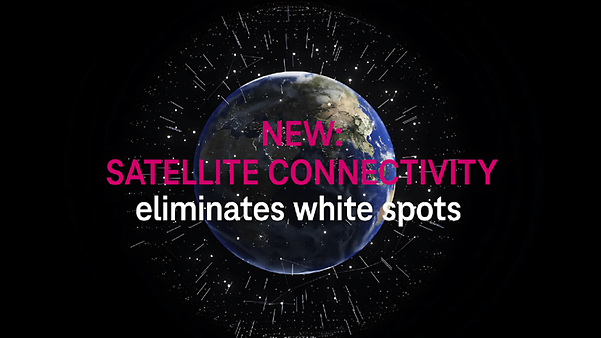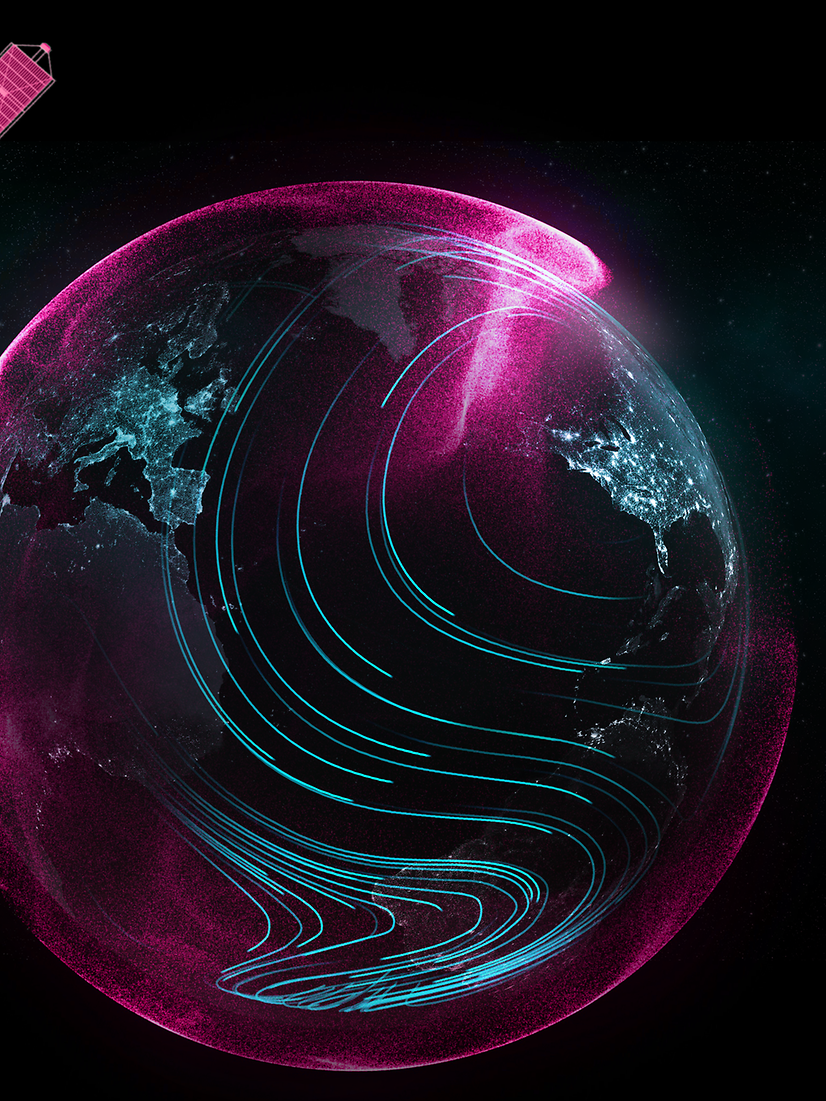Clever Combo: Cellular plus Satellite for Global IoT
The combination of mobile and satellite radio provides globally available connectivity for many industries—on land, at sea, and in the air.
In brief
- By combining mobile communications and satellite technology, Telekom offers global IoT connectivity – even in remote locations or on the high seas.
- Companies benefit from seamless network switching, simplified management via a dashboard, and secure, scalable data transmission.
- Practical examples range from wind turbines with demand-driven lighting and water level monitoring to testing autonomous ships.
Connected without borders: Telekom combines mobile communications and satellite for global IoT connectivity
An offshore wind farm in the North Sea. An avalanche measuring station in the Alps. A container on its way from Hamburg to Buenos Aires. A copper mine in Chile. Until now, connecting and monitoring remote locations and goods worldwide has been costly and inefficient. Yet for many companies, it is crucial to receive reliable live information about their factories, vehicles, machines, and deliveries – even if they are located in areas without stable network coverage or are constantly on the move. This is especially true when it comes to critical infrastructure or employee safety.
That's why Telekom is now combining mobile and satellite communications: Through our collaboration with partners Intelsat and Skylo, companies can access both mobile and satellite connectivity for their IoT applications worldwide and manage these networks via a single platform.
Satellite IoT: Global Telekom Connectivity
Hybrid mobile-satellite connectivity via Deutsche Telekom offers complete global coverage with guaranteed data rates. There is no need to manage different contracts or integrate different systems: the offering, developed in collaboration with Intelsat, includes a service with an integrated dashboard on our T IoT Hub. There is also an API set for all IoT applications. Separate devices for mobile and satellite communications are also unnecessary. Integrated 5G radio modules switch seamlessly and automatically between terrestrial and non-terrestrial networks. Thanks to the solution from our partner Skylo, narrowband technologies such as NB-IoT can also be integrated in the future.
Further information on the Satellite IoT offering can be found here.

On land, at sea and in the air
This combination offers countless networking possibilities, whether it's mobile connectivity in the depths of the Amazon rainforest, tracking shipping containers on the Pacific Ocean or digitally connecting vineyards in the Spanish region of Navarra. Let's take a closer look at some specific examples.
Similar use case or any questions?
Simply fill out the contact form – we’ll get back to you as soon as possible.
Less light pollution in wind farms
Wind turbines are subject to strict air safety regulations and control measures. For example, warning lights are mandatory on wind turbines that are up to 130 metres high. With convergent IoT connectivity from mobile and satellite radio, the safety light can be controlled depending on the current environmental conditions. IoT thus ensures safety for aircraft and at the same time makes the plant more sustainable: the networked system minimises energy consumption through demand-based control and reduces disruptive light emissions at night.
The offering from Telekom in cooperation with Intelsat connects the night lighting systems from Lanthan Safe Sky to wind turbines in particularly remote areas that do not yet have adequate mobile phone coverage. The safety of flight operations is the top priority here. To this end, the systems must transmit their light signals in a fail-safe manner. In addition, there are strict environmental regulations to keep light pollution and interference with nature to a minimum. These are high demands on permanent network availability with very frequent data transmissions. A clear case for connectivity via satellite and mobile communications.
Greater safety on waterways
Another application for satellite IoT that also improves safety conditions is water data management. While water levels in rivers near populated areas and flood risks can usually be monitored easily via IoT mobile connectivity, the situation is different in remote locations. With the help of converged mobile and satellite IoT connectivity, experts and warning services can keep an eye on rivers and other bodies of water even in uninhabited areas. This means greater safety and better response options to protect people and the environment.
Data specialist Divirod helps local authorities and companies to provide information and warnings about water risks quickly and digitally. To do this, digital sensors record water levels in reservoirs and rivers, monitor coastlines and even measure the amount of snow on roofs. The solutions have already been tried and tested many times: for example, sensors in risk areas such as Florida collect water data to prepare for storms and protect Venice's cultural heritage from flooding. The Federal Waterways and Shipping Administration (WSV) is currently testing this service. The aim is to collect valuable data on water levels, flow rates, temperature and quality in AI quality. This requires an uninterrupted data flow over several weeks. With Satellite IoT, this is now possible.
Better connectivity for autonomous ships
Research into autonomous ships is progressing rapidly. One of the challenges is providing reliable and secure offshore connectivity. A combination of mobile and satellite IoT enables data exchange between the ship and the control centre, even on the high seas. While specific regulations for autonomous ships are still pending, the technology is already enabling trials that bring us closer to autonomous shipping on the world's oceans.
Satellite communication represents a milestone for shipping. A stable, high-performance broadband connection even on the ocean opens up completely new application scenarios. Autonomous watercraft are now conceivable: the first shipping companies are currently testing the exchange of technical data between ships and control rooms via 5G mobile communications and satellite. The ships are in use worldwide; until now, companies usually had to conclude numerous cooperation agreements in different countries for digital networking. The new Satellite IoT solution makes this easier, as Telekom offers a single, globally valid contract.
Scenarios for a Combination of Cellular and Satellite Communication
- Remote areas: in rural or remote areas where mobile phone coverage is limited or non-existent
- Emergency and disaster relief: during natural disasters or other emergencies where terrestrial infrastructure has been damaged or destroyed, to maintain communication between rescue workers and aid organisations
- Shipping and offshore industries: ships and offshore platforms require reliable communications for navigation, weather information, emergency communications and general operational requirements
- Aviation: aircraft, especially on long-haul flights, benefit from air safety, navigation, communications with air traffic controllers and the provision of Wi-Fi services on board
- Transport and logistics: in the transport and logistics industry, track the location and condition of vehicles, containers or goods in real time, even in remote areas without mobile phone coverage
- Research and environmental monitoring: research facilities and environmental monitoring stations in remote areas or on the high seas can transmit data in real time to researchers or decision-makers
IoT Connectivity

IoT Connectivity
The right IoT connectivity coordinates IoT connections across platforms, integrates devices and data via API, and enables global control with the highest security standards. You can manage your IoT projects flexibly, efficiently, and independently of manufacturers.

Ümit Günes
Marketing Manager IoT
Having been with Telekom since 2008, Ümit possesses a comprehensive understanding of various facets of the Internet of Things. He has a keen interest in the digital transformation of the business world. On this blog, he shares insights into the latest developments and trends in the IoT sector that provide genuine value to customers.